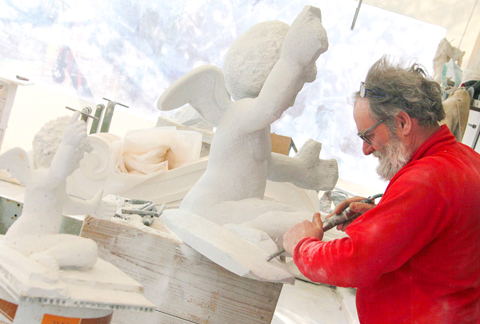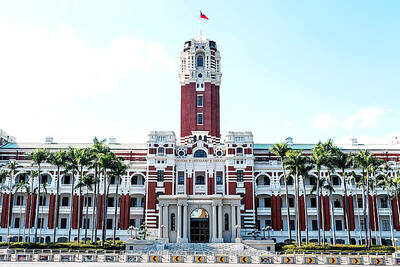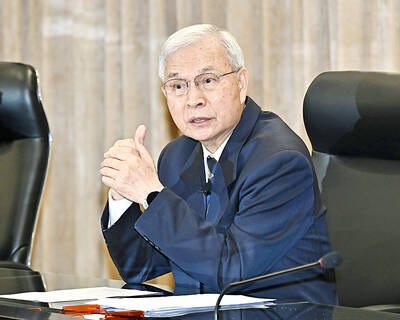Carrara marble, the stuff of Michelangelo’s David and a symbol of Italian luxury, has run into hard times amid the world financial crisis and growing competition from abroad.
“The finishing of marble and other materials such as granite is in a very deep crisis,” said Marco Tonelli, a city official in Carrara, the Tuscan home of the famous white and blue-gray stone.
“China, as well as India and Brazil, have invested in tools to work marble and granite, and now they are finishing it locally instead of sending it to Carrara as they used to,” said Roberto Dell’Amico, who owns a workshop in Carrara that his father opened 45 years ago.

PHOTO: AFP
“Twenty or 30 years ago, most marble or granite produced in the world was finished in Carrara, but today that is no longer the case,” said Dell’Amico, who employs 13 men, down from 18 a decade ago.
Exports last year of finished marble products and granite dropped 16 percent and 27 percent respectively from a year ago in terms of value, experts say, while unions say some 2,000 jobs have been lost in recent years.
Brazil, a major producer of granite, cuts its own blocks at much more competitive prices and exports them directly.
“We should export our know-how, because even if we will never be able to compete with the Chinese in simple cutting of marble, we can still rival them in finishing thanks to our artisans who often work the material by hand,” Dell’Amico said.
“There’s no school for learning this skill,” said Alvise Lazzareschi, 52, the descendant of a noble Tuscan family whose ancestors have extracted marble for five centuries.
“You learn it when you are little, when dad comes home and starts cursing a rock that cracked in the wrong place,” he said.
Lazzareschi also noted the dangers of marble-cutting, an all-male domain.
Few have not lost family members in the quarries, despite strengthened safety norms through the years.
“We can’t work if it’s too cold, or if it’s too hot, or if there’s too much rain or wind. We work between 160 and 170 days a year,” said Franco Petacchi, 50.
“I have 24 employees, all men. It’s a difficult skill and dangerous. You won’t find a woman in a quarry,” Petacchi said, pointing to a statue of his uncle, who died in a mining accident.
Petacchi’s grandfather was a quarry foreman, while his father had a concession, which he took over.
The town earns about 15 million euros (US$20 million) a year in taxes and concessions.
While demand for cutting and finishing is down, extraction continues apace at a rate of about 1 million tonnes of marble per year.
The supply appears limitless, leading Lazzareschi to remark with confidence: “The world will end before Carrara marble runs out.”
Antonio Chiappini, another expert, said that the activity had little waste.
“Marble is like a pig. You don’t throw anything away, from the noble product, to the earth which is used for backfill, to the debris used to make calcium carbonate,” used in the food and cosmetic industries, Chiappini said.
“I have no problems with the Chinese or others copying me,” said Alberto Devoti, who runs cutting and finishing operations. “I simply have to stay ahead of the game by always offering something new [so that] those who copy will always come in second.”
Despite the help of high-tech equipment — digitized machinery and high-pressure waterjet cutting machines — Devoti says it is the artisan who makes the difference.
“The top of this marble column required two weeks of work by hand, using a chisel and sandpaper, to obtain the desired result,” Devoti said, caressing the ornate piece.
Devoti’s two brothers and his son work also for the family business that has won lucrative contracts overseas, such as cladding a mosque in Oman with marble.
They have also come up with innovative products such as thin, undulating marble plaques decorated with copies of Dutch painter Piet Mondrian’s geometric creations.
However, with the financial crisis and competition biting into revenues, the sector “needs the help of the political world to promote products, fund research and spur banks to support small companies,” Devoti said.
Marble finishers “suffer from their small size and their isolation, and they have been unable to join forces,” Tonelli said.
“All in all, these companies have been unable to cope with the end of their near-monopoly on finishing marble and granite,” he said.

The CIA has a message for Chinese government officials worried about their place in Chinese President Xi Jinping’s (習近平) government: Come work with us. The agency released two Mandarin-language videos on social media on Thursday inviting disgruntled officials to contact the CIA. The recruitment videos posted on YouTube and X racked up more than 5 million views combined in their first day. The outreach comes as CIA Director John Ratcliffe has vowed to boost the agency’s use of intelligence from human sources and its focus on China, which has recently targeted US officials with its own espionage operations. The videos are “aimed at

STEADFAST FRIEND: The bills encourage increased Taiwan-US engagement and address China’s distortion of UN Resolution 2758 to isolate Taiwan internationally The Presidential Office yesterday thanked the US House of Representatives for unanimously passing two Taiwan-related bills highlighting its solid support for Taiwan’s democracy and global participation, and for deepening bilateral relations. One of the bills, the Taiwan Assurance Implementation Act, requires the US Department of State to periodically review its guidelines for engagement with Taiwan, and report to the US Congress on the guidelines and plans to lift self-imposed limitations on US-Taiwan engagement. The other bill is the Taiwan International Solidarity Act, which clarifies that UN Resolution 2758 does not address the issue of the representation of Taiwan or its people in

US Indo-Pacific Commander Admiral Samuel Paparo on Friday expressed concern over the rate at which China is diversifying its military exercises, the Financial Times (FT) reported on Saturday. “The rates of change on the depth and breadth of their exercises is the one non-linear effect that I’ve seen in the last year that wakes me up at night or keeps me up at night,” Paparo was quoted by FT as saying while attending the annual Sedona Forum at the McCain Institute in Arizona. Paparo also expressed concern over the speed with which China was expanding its military. While the US

SHIFT: Taiwan’s better-than-expected first-quarter GDP and signs of weakness in the US have driven global capital back to emerging markets, the central bank head said The central bank yesterday blamed market speculation for the steep rise in the local currency, and urged exporters and financial institutions to stay calm and stop panic sell-offs to avoid hurting their own profitability. The nation’s top monetary policymaker said that it would step in, if necessary, to maintain order and stability in the foreign exchange market. The remarks came as the NT dollar yesterday closed up NT$0.919 to NT$30.145 against the US dollar in Taipei trading, after rising as high as NT$29.59 in intraday trading. The local currency has surged 5.85 percent against the greenback over the past two sessions, central